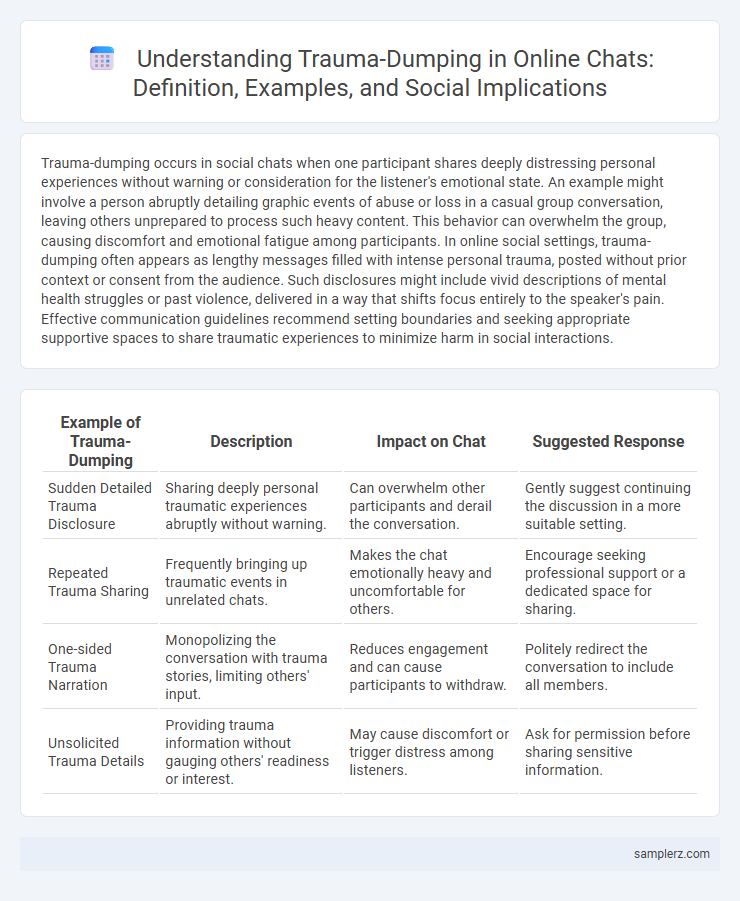Trauma-dumping occurs in social chats when one participant shares deeply distressing personal experiences without warning or consideration for the listener's emotional state. An example might involve a person abruptly detailing graphic events of abuse or loss in a casual group conversation, leaving others unprepared to process such heavy content. This behavior can overwhelm the group, causing discomfort and emotional fatigue among participants. In online social settings, trauma-dumping often appears as lengthy messages filled with intense personal trauma, posted without prior context or consent from the audience. Such disclosures might include vivid descriptions of mental health struggles or past violence, delivered in a way that shifts focus entirely to the speaker's pain. Effective communication guidelines recommend setting boundaries and seeking appropriate supportive spaces to share traumatic experiences to minimize harm in social interactions.
Table of Comparison
| Example of Trauma-Dumping | Description | Impact on Chat | Suggested Response |
|---|---|---|---|
| Sudden Detailed Trauma Disclosure | Sharing deeply personal traumatic experiences abruptly without warning. | Can overwhelm other participants and derail the conversation. | Gently suggest continuing the discussion in a more suitable setting. |
| Repeated Trauma Sharing | Frequently bringing up traumatic events in unrelated chats. | Makes the chat emotionally heavy and uncomfortable for others. | Encourage seeking professional support or a dedicated space for sharing. |
| One-sided Trauma Narration | Monopolizing the conversation with trauma stories, limiting others' input. | Reduces engagement and can cause participants to withdraw. | Politely redirect the conversation to include all members. |
| Unsolicited Trauma Details | Providing trauma information without gauging others' readiness or interest. | May cause discomfort or trigger distress among listeners. | Ask for permission before sharing sensitive information. |
Recognizing Trauma-Dumping in Online Conversations
Trauma-dumping in online conversations often manifests as overwhelming disclosures of personal trauma without consent, disrupting the flow and emotional balance of the chat. Recognizing trauma-dumping involves identifying unsolicited, intense sharing of past abuses or emotional pain that places undue burden on others in social platforms like forums, group chats, or social media threads. Awareness of these signs enables users to maintain healthier communication boundaries and support dynamics within digital communities.
Common Signs of Trauma-Dumping in Chats
Common signs of trauma-dumping in chats include excessive sharing of deeply personal or distressing experiences without receiving consent, abrupt shifts to heavy emotional topics unrelated to the current conversation, and overwhelming the recipient with intense feelings in a single message. Messages often lack boundaries and may monopolize the chat, leaving little room for reciprocal dialogue or support. Recognizing these signs helps maintain healthy communication and emotional balance in social interactions online.
Real-Life Chat Examples of Trauma-Dumping
Real-life chat examples of trauma-dumping often involve sudden, overwhelming disclosures of personal trauma without consent, such as a friend abruptly sharing intimate details of abuse or grief in a casual group chat. These interactions can cause emotional distress and discomfort for recipients unprepared for such heavy content, highlighting the need for clear boundaries and empathetic communication. Recognizing trauma-dumping is crucial to fostering supportive online environments and maintaining healthy social connections.
The Impact of Trauma-Dumping on Group Chats
Trauma-dumping in group chats often leads to emotional overload, causing members to feel overwhelmed and helpless. This behavior can disrupt the supportive dynamic, leading to reduced participation and increased avoidance within the group. Persistent trauma-dumping may result in decreased trust and fractured relationships, undermining the chat's original purpose of fostering connection.
How Trauma-Dumping Differs from Healthy Sharing
Trauma-dumping in chat occurs when someone overwhelms others with detailed, intense accounts of personal trauma without considering the listener's emotional capacity or consent. Healthy sharing involves expressing feelings and experiences in a balanced way, allowing space for mutual support and empathy. Trauma-dumping often disrupts social interactions by creating emotional burden, whereas healthy sharing fosters connection and understanding.
Responding to Trauma-Dumping in Digital Spaces
When someone trauma-dumps in chat, responding with empathy and setting clear boundaries is essential to maintain a healthy digital environment. Offering supportive messages like "I'm here to listen, but please consider if this is the right time for heavy discussions" validates emotions without overwhelming the responder. Encouraging professional help and redirecting the conversation ensures both parties' well-being and prevents emotional burnout in online communities.
Emotional Boundaries During Chat-Based Trauma-Dumping
Emotional boundaries are crucial when someone engages in trauma-dumping during chat conversations, as oversharing intense personal experiences can overwhelm recipients and hinder effective support. Maintaining clear limits on the depth and timing of disclosures helps protect both parties from emotional fatigue and fosters a respectful communication environment. Recognizing signs of discomfort or disengagement in text responses signals the need to pause or redirect the dialogue to ensure balanced and healthy interactions.
Navigating Repeated Trauma-Dumping in Friend Groups
Repeated trauma-dumping in friend groups often manifests as one individual persistently sharing distressing personal experiences without seeking mutual support or boundaries. This behavior can lead to emotional exhaustion and discomfort among other members, undermining trust and group cohesion. Establishing clear communication and promoting balanced sharing helps maintain a supportive environment while respecting individual limits and mental health.
Trauma-Dumping and Compassion Fatigue in Online Communities
Trauma-dumping in online communities occurs when individuals repeatedly share traumatic experiences without warning, overwhelming other members and disrupting group dynamics. This behavior can lead to compassion fatigue, where community members become emotionally exhausted and less able to offer support or engage empathetically. Effective moderation and clear community guidelines are essential to balance open expression with emotional safety for all participants.
Encouraging Supportive Yet Respectful Chat Dialogue
Trauma-dumping occurs when someone shares overwhelming personal pain without considering the listener's emotional boundaries, potentially causing discomfort or distress. Encouraging supportive yet respectful chat dialogue involves setting clear communication boundaries and validating emotions while gently steering conversations toward mutual comfort. Promoting empathy and active listening helps maintain a safe space where individuals feel heard without feeling overwhelmed.

example of trauma-dumping in chat Infographic
 samplerz.com
samplerz.com